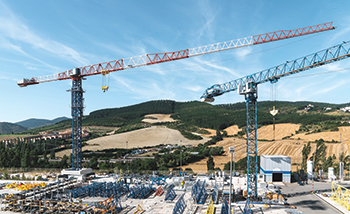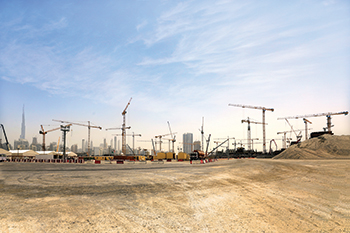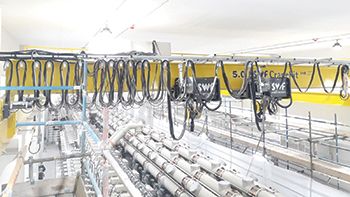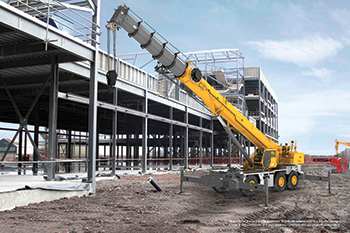
 The flat-top 21LC1050 ... maximum load bearing of 50 tonnes and a 80-m reach.
The flat-top 21LC1050 ... maximum load bearing of 50 tonnes and a 80-m reach.
Comansa, a leading manufacturer of tower cranes for construction, has announced the global launch of its new model, 21LC1050, which has been designed for work on projects that demand heavy lifting capacities.
The high-capacity flat-top tower crane is available in three versions with a maximum load of 25, 37.5 and 50 tonnes and a reach of 30 m to 80 m with configurations every 5 m, says a spokesman for Comansa.
In addition, an optional jib configuration is being offered thus allowing the customer to have a special reach of 85 m.
The characteristics of load, reach and mechanisms of the 21LC1050 make this model ideal for large industrial or mining projects as well as for the construction of buildings with prefabricated and steel structures of great tonnage, says the company.
The Spanish crane manufacturer points out that the design of the slewing (horizontal) part of the 21LC1050 is similar to that of the successful 21LC750 and 21LC660. Instead of having a cusp element, the jib and counterjib join directly on the slewing part, which allows a much faster and safer assembly, it states.
The 21LC1050 also shares a large part of the jib and counterjib sections with its “little siblings” 21LC750 and 21LC660, which allows customers who already own these models to optimise their investment.
Among the highlights of the 21LC1050 is the design of its counterjib, which, like the jib, allows numerous different configurations to better adapt to the needs of each job.
“Having a counterjib radius as short as possible avoids possible interference with buildings or other cranes present in the same project, thus increasing safety,” says the spokesman.
“The entire structure of counterjib consists of five modular elements that allow up to six different configurations. Thus, when the crane is assembled with a maximum range of 80 m, the counterjib radius is 31 m, being able to reduce, for example, to 27 when the jib is 50 m, or to 21 when the reach is 30 m. In addition, the counterjib radius in all its configurations can be reduced by one additional metre with steel counterweights, which are offered as an optional element,” he explains.
The 21LC1050 is erected on a new tower section 2.5 m in width, compatible with the rest of the mast sections of the same width from Comansa. In the version with fixing angles, the 21LC1050 reaches a freestanding height of 73.3 m, and exceeds 98 m when combined with other sections of larger width from Comansa.
Like the rest of Comansa’s flat-top models, the 21LC1050 comes standard with the PowerLift system, which allows the crane to improve the load diagram by 10 per cent, without exceeding the nominal capacity. In this way, if the jib-end load of the 25-tonne model is 10,800 kg, when the crane driver operates the PowerLift system from the controls, the maximum load at the jib end increases to 11,880 kg, says the spokesman.
Another new feature is its climbing cage, the J3-20. This hydraulic cage is compatible with other models from Comansa, like the LCL700 luffing-jib crane, and has a pushing force of 200 tonnes, greater than any other jacking cage for 2.5-m-wide mast sections from the manufacturer. In addition, this new cage introduces other innovations to Comansa’s range of cages, since it speeds up the climbing process and reduces assembly time, he states.
The 21LC1050 comes standard with the new Cube cab in its XL version, the most spacious from Comansa. This cabin, which has received the prestigious “iF” design award, ensures great productivity thanks to its fully glazed front and provides great comfort to the operator of the machine.
Thanks to its maximum load of 50 tonnes, the 21LC1050 is the largest capacity crane of the successful Comansa 2100 Series which comprises flat-top models of large tonnage. This crane is only surpassed by the LCL700 luffer, with 64 tonnes of maximum load, and the flat-top models 30LC1100 and 30LC1450, which have maximum loads of 64 and 90 tonnes respectively, it adds.





















_0001.jpg)


.jpg)
















.jpg)








.jpg)






